This is a Kodak Colorsnap 35 Model 2, a 35mm scale focus viewfinder camera made in London, England by Kodak Ltd. London between 1964 and 1967. It was a refreshed version of the original Kodak Colorsnap 35 which started production in 1959. Both Colorsnap cameras were created by the British version of Kodak in response to the growing popularity of color 35mm film and would have been one of the most popular models for shooting slide film for the era. The Colorsnap has a single speed shutter, mounted behind a Kodak Anaston lens and uses a “dial by weather” system of controlling exposure using the diaphragm. Although rudimentary in design, it worked quite well when used within the camera’s limitations. This model is not often found outside of the UK, but nevertheless is a curious and well designed Kodak from the company’s golden era of camera design for the purpose of selling film.
Film Type: 135 (35mm)
Lens: 44mm f/3.9 Kodak Anaston coated 3-elements in 2-groups
Focus: 2.5 feet / 0.8 meters to Infinity
Viewfinder: Scale Focus Viewfinder
Shutter: Dakon Leaf
Speeds: Single Speed, ~1/40
Exposure Meter: None
Battery: None
Flash Mount: Brownie Flasholder 3 Mount
Other Features: None
Weight: 454 grams
Manual (similar model): https://www.flickr.com/photos/dr_charles/albums/72157611355288472/
How these ratings work |
The Kodak Colorsnap 2 Model 2 is an interesting UK only camera that despite having a simple interface and unique cosmetics, isn’t much different from Kodak’s midcentury US models. I found it to be easy to use and it made good images, but it doesn’t do anything Kodak’s US models couldn’t do. For the collector of British cameras or those not commonly found in the United States, it would be a compelling addition to your collection, but doesn’t offer anything you can’t already find in easier to find models. | ||||||
| Images | Handling | Features | Viewfinder | Feel & Beauty | History | Age | |
| 1 | 1 | 1 | 1 | 1 | 1 | 20% | |
| Bonus | none | ||||||
| Final Score | 7.2 | ||||||
History
The United Kingdom may not be the country you first think of as a prominent source for cameras from the 20th century, but that doesn’t mean they didn’t contribute. Brands like Ensign, Ilford, and Purma are some of the more common makes found, and for the really deep pocketed collector, there was the Reid, but of all the companies that made cameras in the United Kingdom, the most common was Eastman Kodak, or more precisely, Kodak Limited London.
The history for how Kodak cameras were made in the UK dates back all the way to 1891 when George Eastman opened his first location outside of the United States. Located on Headstone Drive in Harrow, North London, the new factory was originally called Eastman Photographic Materials Company, Limited.
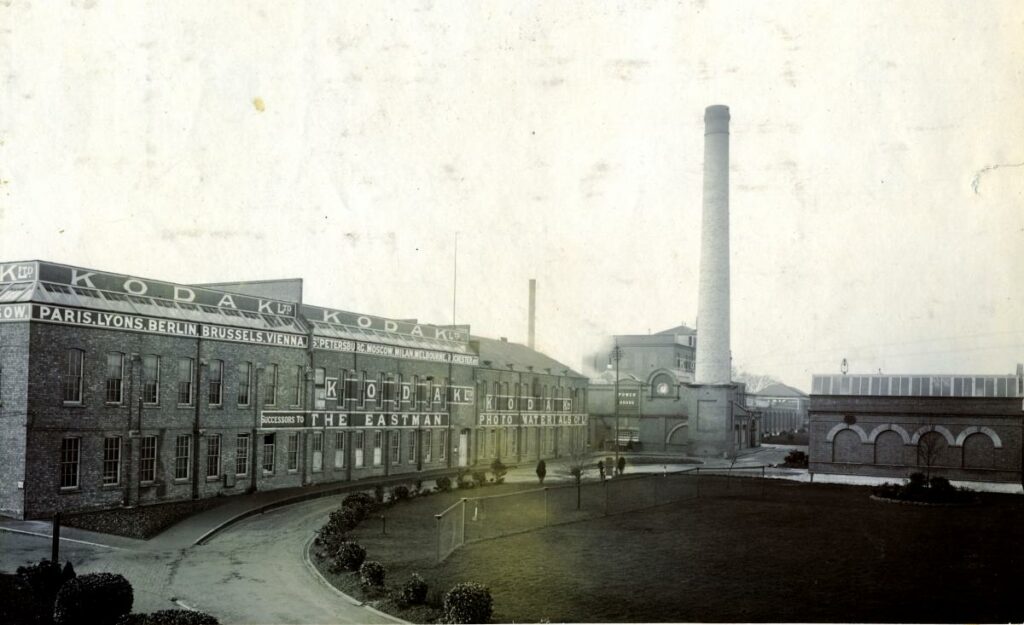
Eastman’s new location was small and it’s primary purpose was as a print shop for it’s British and other European customers. In those days, it was still very common to send developed dry and wet plates back to Kodak for finishing and printing. Since it was not practical to send them overseas back to America, having a location that could do this in England allowed for Eastman to expand his reach across the Atlantic. The Harrow location was very successful and expanded over the next two decades, eventually making Eastman roll film, photographic paper, and other goods.
In the early 20th century, the 7 acre park where the Harrow factory resided saw construction of several new facilities, among them, a research building and a sports complex. By the 1930s, the Harrow location started to produce cameras. Now called Kodak Limited, the London factory built mainly small, inexpensive models that were similar, but not identical to Kodak’s Rochester built models.
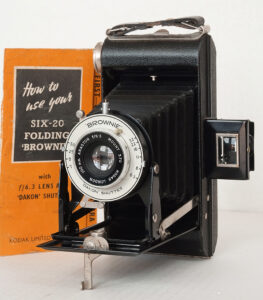
According to Kodak Ltd’s camera-wiki page, a plate camera called the Kodak S1 Mark11 was produced there, but I found no evidence of such a camera in my research for this article. A majority of the early cameras were Vest Pocket and Brownie box cameras that used 120, 127, 616, and 620 films. Models like the Six-20 Folding Brownie were very similar, but not identical to their American counterparts. Usually featuring a slightly different body and different combinations of lenses and shutters, Kodak Ltd’s UK cameras were usually not available in the United States.
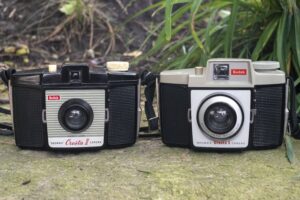
Kodak Ltd saw it’s greatest success in the 1950s and into the early 1960s with many different models in the company’s lineup. By 1955, the company was located on a 55 acre piece of land, and employed about 6000 workers.
While all roll film Kodak cameras made in Rochester used Kodak’s own 620 film format, Kodak Ltd often catered to the more Euro-friendly 120 format with models like the Kodak Brownie Cresta series that exclusively used 120 film.
In 1955, Kodak Ltd built a camera called the Bantam Colorsnap. Taking a name from the American Kodak’s lineup of compact Bantam cameras, the Bantam Colorsnap used Kodak’s 828 format of roll film. Making eight 28mm x 40mm images on a small, paper backed film format, the Bantam Colorsnap finally brought Kodak’s smallest roll film format to England.
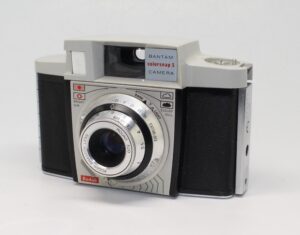
I personally find the introduction of this model in 1955 to be curious as by that time, Rochester was winding down the era of 828 cameras, with only the Pony 828 still in production. The format had fallen out of favor with American buyers over 35mm type 135 film which was popularized by cameras like the Leica, Zeiss-Ikon Contax, and Kodak AG’s Retina series.
The Bantam Colorsnap was popular enough to be revised twice, with three separate models in the series, produced for eight years, before being discontinued in 1963.
Perhaps seeing the popularity of 35mm film in the United States, in 1959, Kodak Ltd would release it’s first, and only 35mm camera called the Kodak Colorsnap 35. Sharing a similar name as the Bantam Colorsnap, the 35mm model looked quite a bit different. Featuring an all new body, the Colorsnap 35 targeted the color Kodachrome and Ektachrome slide film market that was huge in the United States. It featured a simple, single speed shutter, a ‘good but not great’ 3-element 44mm f/3.9 Anaston lens, and an exposure system that relied on icons and exposure scenes to measure exposure. The camera was fully mechanical, but very simple to use.
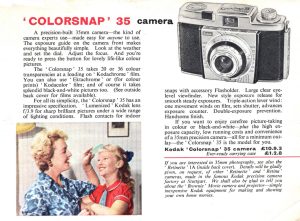
Although slightly resembling the American Kodak Pony, the Colorsnap 35 was totally unique, with a large and black plastic shutter release set in a stepped top plate. On the side, the Colorsnap 35 supported Kodak’s international Brownie Flasholder and was fully flash synced.

Advertisements for the Colorsnap emphasized it’s simplicity, along with the high capacity 20 and 36 exposure cassettes offered by 35mm film. The camera sold for a modest £10.9.3 which was barely more than what a single cassette of 36-exposure 35mm Kodachrome cost at the time.
The Colorsnap 35 was successful enough to be supplemented in 1962 by an auto exposure version called the Kodak Auto Colorsnap 35, and succeeded in 1964 by a Model 2 Colorsnap 35 which featured revised cosmetics, a cleaner and flat top plate, and better support for filters, but was otherwise the same camera.
The Colorsnap series remained in production until 1967 making it one of the longest running single models built in England, and the company’s sole attempt at a 35mm camera.
By the late 1960s, the only cameras coming out of Harrow were Kodak’s inexpensive Instamatic models. These cameras were produced until the late 1970s at which point the factory stopped camera production altogether. Despite no longer being a camera maker, Kodak Ltd remained relevant for the next several decades, changing it’s focus to making film and other supplies for the photographic industry.
Kodak retained it’s presence in Harrow until 2005 when all film production ended. At least 1,400 employees remained employed until at least 2012 when Kodak Alaris took over Kodak’s UK operations at which time it is unclear what was being produced (if anything at all) at the location. The factory and it’s grounds remained in use until 2017 at which time the entire factory was permanently closed, ending over 120 years of Kodak in the area.
Today, Kodak’s presence in England is fondly remembered by those in the area, and for those who owned them, Kodak cameras were a big part of their history. For the rest of the world, we don’t often get to see the British Kodak models. When examples like the Colorsnap 35 do make it to other countries, they are rarely looked at with any higher regard than comparably inexpensive US built models. Still, Kodak was always a film first company who made cameras in an effort to sell more film, and many of the company’s mid century models were capable shooters, so models like the Colorsnap 35 are capable of good results if you’re so inclined to give one a chance.
My Thoughts
It is no secret that in the mid 20th century, Eastman Kodak’s camera output was 99% driven to sell more film. The more people who owned Kodak cameras, the more customers there would be to buy Kodak film. Of course, there’s nothing stopping someone who doesn’t own a Kodak camera from still buying Kodak film, or vice versa, but Kodak’s proactive approach to always creating new customers is the reason they were the number one film company in the world for nearly a century.

So far, all of the Kodak cameras I’ve written about on this site have been either American or German models, but Kodak was in far more places than just the US and Germany. Models made in Brazil, France, and England exist, so when I had a chance to try out a British Kodak that was never sold in the US, I was pretty excited.
This Kodak Colorsnap 35 Model 2 camera was gifted to me by fellow blogger Alan Duncan from Canny Cameras. Alan and I have been in a camera bloggers group chat for a number of years now and has appeared in all three European episodes of the Camerosity Podcast, so if you’re interested in more of Alan’s work or what he is shooting, check out his website or listen to those episodes.
The Colorsnap series was unique in that it doesn’t have a US equivalent in terms of features. With a single shutter speed, and the only method for adjusting exposure was via icon based “scenes” the camera is very simple. At a weight of 454 grams, the camera is pretty light, although it’s mostly chrome metal over plastic body is pretty sturdy and does not creak in your hands.
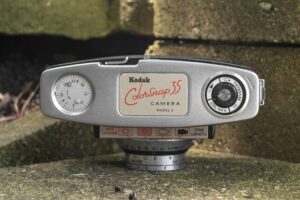
Up top, on the photographer’s left side is the pop up rewind knob with a film reminder dial on top. Normally the rewind knob is recessed into the top plate, but when it comes time to rewind the film, press down on the knob with your thumb and give it a slight twist in the opposite direction of the arrow to get it to pop up. Once it is up, you can rewind the film in the direction of the arrow.
In the center is a large Kodak Colorsnap logo plate. Interestingly, this plate faces forward, making it easier to read from someone looking at the front of the camera, rather than the photographer like pretty much every other camera made. This does make a bit of sense though as anyone who is shooting a camera, likely already knows what it is, so by facing the name of the camera forward, perhaps Kodak thought other people might want to know what it is too.
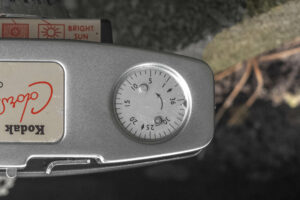
On the photographer’s right is the subtractive exposure counter which counts backwards down to 0, showing how many exposures are left on a roll of film. The exposure counter does not automatically reset and must be set to however many exposures are on a new roll of film.
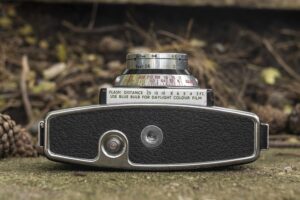
The bottom of the camera is mostly covered in the same type of body covering as the rest of the camera, and has a metal 1/4″ tripod socket in the center. While I normally applaud the use of a balanced tripod socket, I wonder how much use this would get on a camera with a single shutter speed and no self-timer. Next to the tripod socket is the rewind release button for deactivating the film transport.
In front of the bottom, below the shutter, is a flash distance chart for various exposure settings.
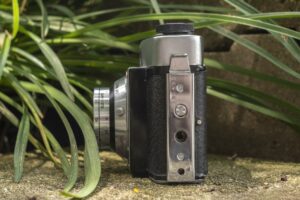
Each side of the camera has a chrome plate. On the right side is an engraving that says the camera is made in England by Kodak Limited London, and on the left side is the combination film door latch release and contact points for the Kodak flash gun. Although this Colorsnap did not come with a flash, I was able to successfully mount a Kodak Midget Flasholder from a Kodak Signet 40, suggesting the flash units were interchangeable. Having the flash connection and door release on the same side is a little odd however, as it makes opening the film door impossible with the flash attached.

Around back, there’s little to see other than the small rectangular eyepiece for the viewfinder, the film advance lever, and nothing else. The back door has nothing on it, not even a film reminder square like what was found on Kodak’s US built cameras like the Signet and Automatic/Motormatic cameras had.
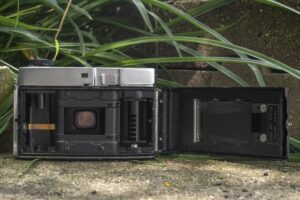
The film compartment is pretty typical with transport from left to right onto a fixed, and single slotted take up spool. Although the spool has only one slot, it is very large with a single tooth that grabs the film leader while inserting a new roll of film into the camera. The pressure plate on the door is painted black metal, but has four curbed notches that line up with similarly shaped indentations above and below the film gate, which helps maintain even pressure on the film as it transports through the camera. A messaged, silk screened on the inside of the door reminds you to use Kodak 135 film. The film compartment has light seals made of foam, which on this model had degraded. I would definitely recommend replacing these before shooting any film in this camera but if you’re lazy and just want to get a single roll shot, be sure to tape over the seams with something like electrical tape once film is loaded in the camera.
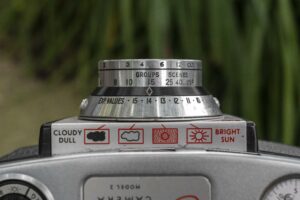
Looking down upon the top of the shutter, we see the icons for the camera’s simplified exposure system. Although the Colorsnap lacks a meter, it’s icon based system works well and is easy enough for the most novice of photographers to understand. A thin ring around the shutter closest to the body, calibrates the system for whatever speed film is loaded into the camera. A scale below the shutter has marks for ASA film speeds from 10 – 640 are indicated. Line up the notch on the ring to whatever speed film is loaded in the camera, and when you’re ready to make your exposure, choose whichever of the four exposure icons most closely match the type of light you are in. Icons from Dull Clouds to Bright Sun can be selected. The main exposure dial around the shutter has a “V” shaped notch near it’s top which lines up with whichever of the icons you wish to select. Two arrows to the left and right of the notch for Dark and Light can be used for intentional under or over exposure, but I suspect most people just used the main notch.
Up front, the focus ring is around the front lens grouping. As this is a British made camera, focus distances are marked both in meters from 0.8 to infinity and feet from 2.5 to infinity.
Perhaps the camera’s most interesting feature is the front shutter release button, which is made of black plastic and is exactly the same shape and size as the main viewfinder opening, which from a distance could trick someone into thinking this might be a second window for a rangefinder. Although I usually like front mounted shutter releases as they help stabilize the camera at slow shutter speeds by bracing it into your face, but I found the location of the shutter release on this camera in an awkward position, too close to the top plate of the camera. Another complaint I have is that the button is flush mounted with the front of the camera, requiring you to shove your finger into the rectangular opening, pressing the button a good deal into the camera to the point where it actually trips the shutter.

The rear eyepiece for the viewfinder is very small, but when pressing the camera to my face, I could still see all four edges of the viewfinder while wearing prescription glasses. The viewfinder itself is just a simple straight through optical window. There is nothing to help with focus, nor are there frame lines or any indications of exposure.
The Colorsnap 35 series was always intended to be easy to use, and with a full focusing lens, and the company’s easy to use exposure system, I’d say it definitely accomplishes it’s mission. With a clean and interesting design of the front shutter release, the Colorsnap 35 looks like no other Kodak, which for me is it’s greatest asset. Despite it’s modest feature set and widespread use of plastic, I’ve learned never to judge even the simplest of Kodak cameras without using them first, as the company was very good at getting the most out of very little, so what is the camera light to shoot? And most importantly, what kinds of images does it make? Keep reading…
My Results
For the first roll of film in the Kodak Colorsnap 35 Model 2, I went with black and whi….just kidding! I figure that for a camera to have “Color” in it’s name, I probably should shoot some color film. So as the fall colors were starting to turn from vibrant oranges and reds to murky shades of brown, I loaded up some fresh Fuji 200 and attempted to salvage whatever was left of good photo opportunities in my area.
I am a huge fan of Sunny 16 and have never had an issue with guess focus cameras, but while shooting the Colorsnap, estimating exposure using a single shutter speed and icons instead of f/stops on a camera without any sort of focus assist was a harrowing experience. There was more than one occasion where I’d take a shot and think to myself, “there’s no way that’s coming out”. But I didn’t let my doubts get the best of me, so I finished the rest of the roll and added it to my development queue.
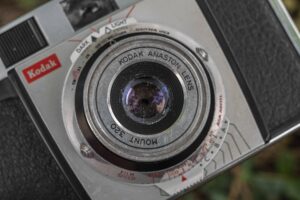
As I pulled the strip of developed film from my Paterson tank, my fears were largely put to rest. I had what looked to be a whole roll of properly exposed and in focus images that I couldn’t wait to scan into the computer.
After getting a good look at the images on a large screen, I could see that several of the images were maybe a stop or two underexposed as I was a little too ambitious in scenes with the evening sun where I shot a large number of images. My typical mirror selfie came out properly, although it shows a light leak which appeared on a few images. My observation that the foam light seals in the film compartment had degraded should have prompted me to tape the hinge side, but I didn’t. If I were to shoot this camera again, I’ll definitely want to get that corrected.
Overall though, the images came out nice! Sharpness in the center was typical of a Kodak triplet, as was the softness near the edges. The 44mm Anaston is not a bokeh monster, so it would be foolish to attempt to use it that way, but I did notice some mushy out of focus details, so I suppose if you tried hard enough you might get some cool bokeh if you had enough patience. More impressive was the wide depth of field afforded by the lens. With the camera largely spent in one of the sunlight scenes, depth of field at 15 feet means anything from 7 feet to infinity will be in focus, making this an outdoor focus free camera. If you want to focus a little closer, at the 5 foot setting, sunlight photos from 3 to 22 feet are in focus, allowing for quick and easy portraits and group photos to be taken.
The Kodak Colorsnap’s greatest strength is it’s simplicity, but in some ways, I think it’s it’s greatest weakness. In order to use this camera properly, you definitely need to use it to it’s strengths without pushing any of it’s limited. The simple exposure system does work well, but once again, only when you use it how it was meant to be used. I constantly had doubts while shooting the camera, but that was likely because I struggled to think like how the camera wanted me to.
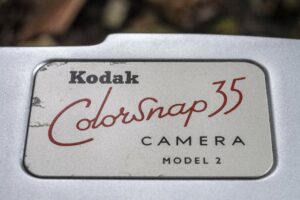
That it doesn’t have a lot of controls, means that you don’t really need to interact with the camera all that much. If you stay in consistent lighting, the focus ring and shutter release are the two parts of the camera you’re most likely to use. Although I usually find front shutter releases to be enjoyable to use, as they help stabilize the camera as you press the shutter release into your face, the one on this camera is recessed in a way that in order to fire the shutter, you have to press your finger into the body of the camera, to trigger it. It’s not difficult to do, just awkward.
The Kodak Colorsnap is meant to be a simple camera, so it should be judged that way. I was happy with the images it made, as likely were the many British men and women who would have bought this camera when it was new. The tiny viewfinder was not an issue for me, nor were the limited exposure options. I did not love the feel of pressing the shutter release, but it didn’t negatively impact the images I was able to make. For US collectors. the Colorsnap is different enough from US Kodaks of the same era to be worth seeking out if you have the chance, but in terms of performance isn’t special enough to stand out from the many models we already have.
I find it interesting that Kodak stayed with inexpensive 35mm cameras into the mid 1960s in England, whereas here in the states, by 1963, if you wanted an inexpensive camera, they were already steering you towards their Instamatics.
Related Posts You Might Enjoy
External Links
http://camera-wiki.org/wiki/Kodak_Colorsnap_35
https://austerityphoto.co.uk/a-very-british-affair-kodak-colorsnap-35-review/
https://cameragocamera.com/2020/04/25/kodak-colorsnap-35/
https://www.youtube.com/watch?v=UL36YULbJs8
https://www.photo.net/forums/topic/491330-the-colorsnap-35-in-autumn/

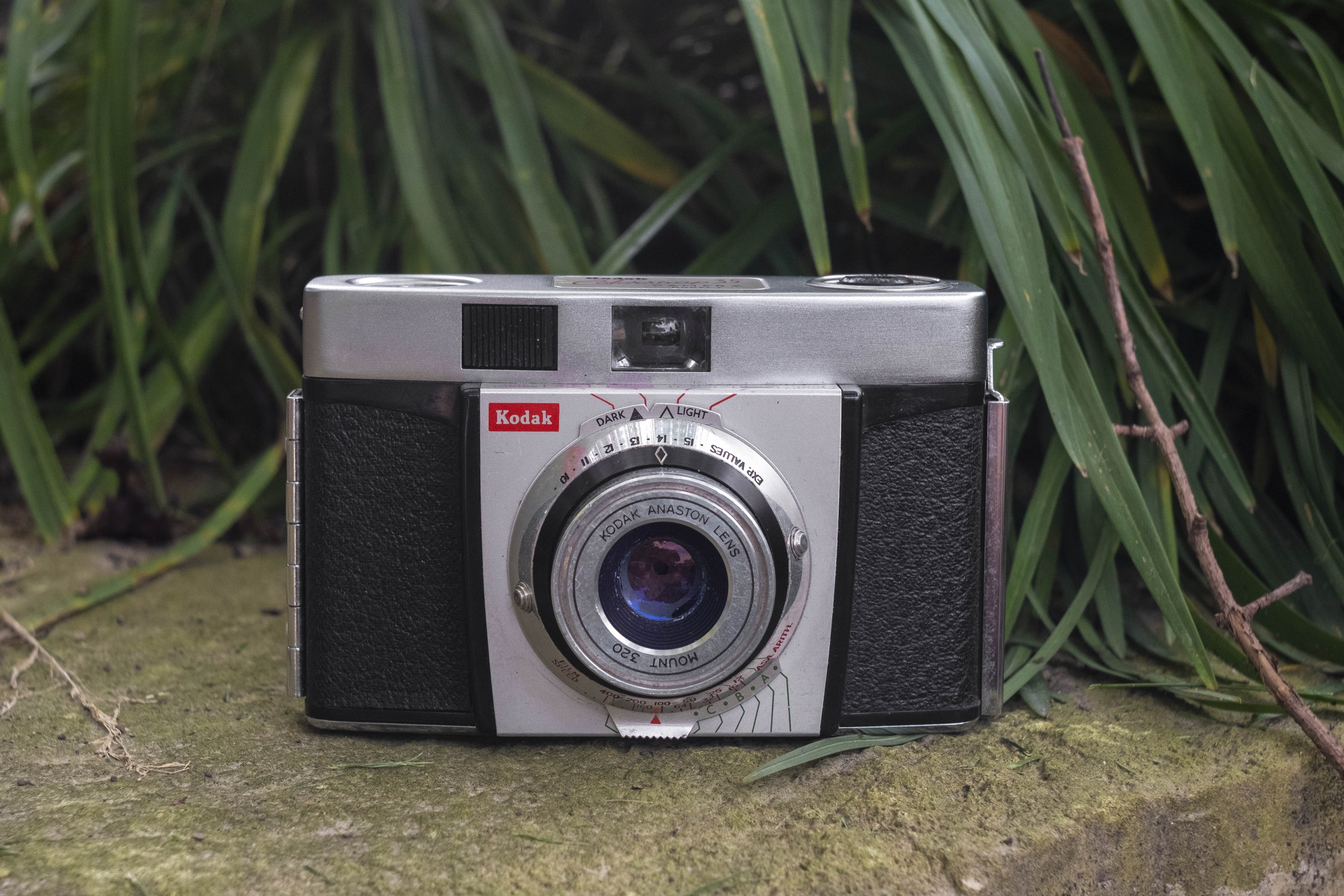
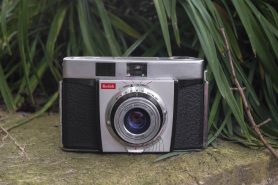
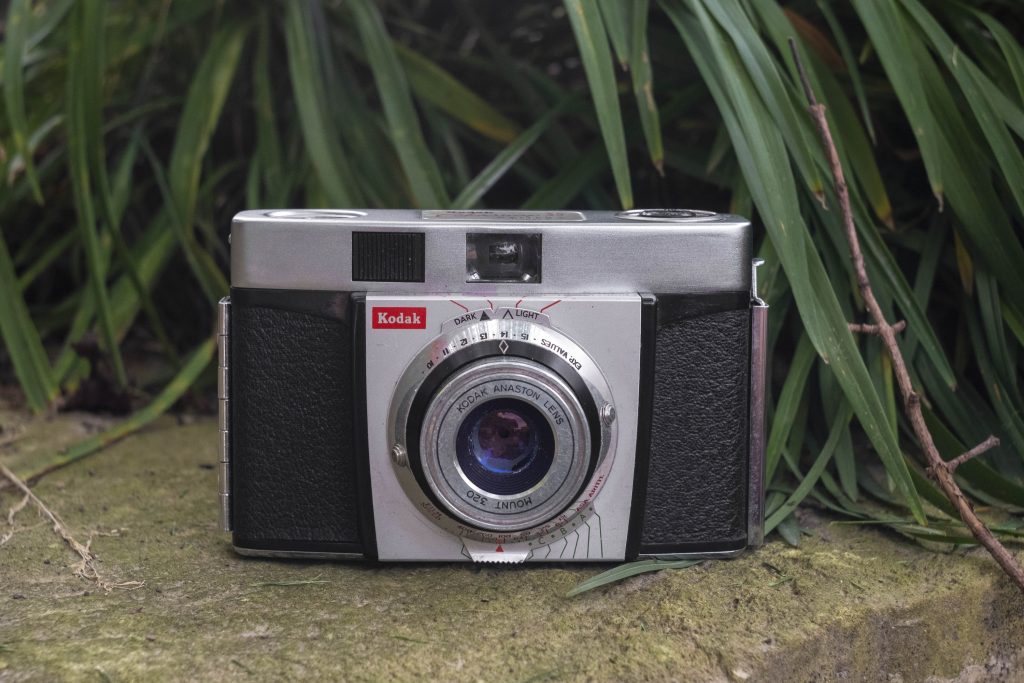















What scanner do you use, do you recommend it? And are the results fairly consistent, I’d like to get one soon. Thanks!